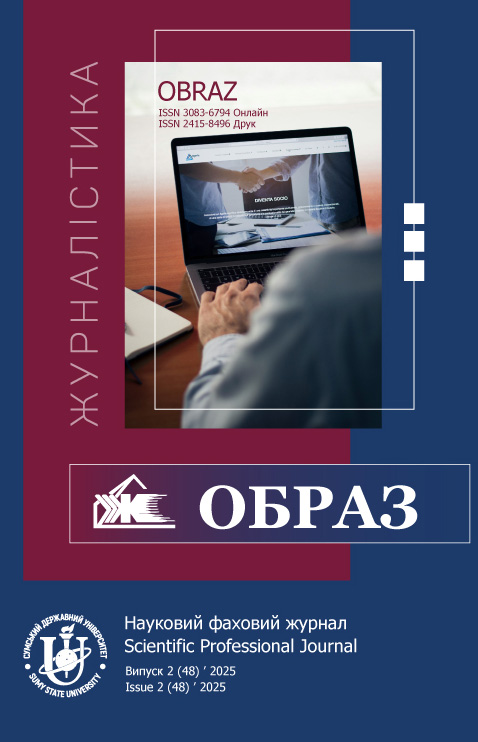Abstract
Introduction. During the full-scale Russian-Ukrainian war, the Telegram platform became one of the leading sources of news for Ukrainians. The messenger's features – anonymity, lack of centralized moderation, and active use by Russian entities – have turned it into a powerful tool for spreading disinformation. This poses serious challenges to information security, which has led to the need for this study.
Relevance and purpose. Despite the high popularity of Telegram, the structural, linguistic, and visual features of disinformation on this platform remain insufficiently studied, especially in the Ukrainian context. The purpose of the study is to identify typical structural, linguistic, and visual features of disinformation content on Telegram, analyze the mechanisms of its dissemination among the Ukrainian audience, and develop a universal system for identifying such messages.
Methodology. The study is based on a content analysis of five popular Telegram channels that systematically broadcast pro-Russian narratives to the Ukrainian audience. The sample is based on the data from the TGStat.ru catalog. The analysis covers messages published in June 2025. The descriptive-analytical method, content analysis, and classification method were used to systematize the results.
Results. It has been established that disinformation content on Telegram is characterized by emotionally colored language, manipulation of facts, lack of references to official sources, use of generalizations, and forged documents. Most channels remain anonymous, which makes it impossible to bring them to justice for spreading fakes. The main mechanisms for spreading disinformation are anonymity, networking, the creation of information echo chambers, and retransmission through related resources.
Conclusions. The identified structural, linguistic, and visual signs of disinformation in Telegram can become the basis for the development of effective tools for detecting and counteracting disinformation campaigns in the information space of Ukraine. The proposed approach contributes to enhancing information security and in-depth monitoring of the information space.
References
1. Butyrina M., Temchenko L. (2023), «Telegram yak seredovyshche prosuvannia rosiyskikh dezinformatsinykh narratyviv: kanaly, metody, freymy», Communications and Communicative Technologies, No. 23, pp. 71–79.
2. Vaskivska O. (2022), «Osoblyvosti informatsiynykh kanaliv sotsialnykh merezh pid chas rosiysko-ukrayinskoyi viyny», Aktualni problemy nauky, osvity ta suspilstva v suchasnykh umovakh: zbirnyk tez dopovidey mizhnarodnoyi naukovo-praktychnoi konferentsii. Poltava, TsFEND, Ch. 2, pp. 72–73.
3. Horbyk R., Dutsyk D., Shalaysky S. (2023), «Efektyvnist’ protydii rosiyskiy dezinformatsiyi v Ukraini v umovakh povnomasshtabnoyi viyny: analitychnyi zvit”. Kyiv, HO «Ukrainskyi instytut media ta komunikatsii», p. 66.
4. Hurzhii S. V. (2021), «Suchasni zahrozlyvi tendentsii vykorystannia Telegram-kanaliv na shkodu derzhavnym interesam», Informatsiia i pravo, No. 4(39), pp. 162–169.
5. Instytut masovoi informatsii (2023), «Anonimnist ta rosiyski hroshi. Khto finansuie ukrainski telegram-kanaly?», available at: https://detector.media/infospace/article/209798/2023-04-05-anonimnist-ta-rosiyski-groshi-khto-finansuie-ukrainski-telegram-kanaly/ (accessed 25 June 2025)
6. Anin R., Kondratyev N. (2025), «Telegram, the FSB, and the Man in the Middle», available at: https://www.occrp.org/en/investigation/telegram-the-fsb-and-the-man-in-the-midd (accessed 25 June 2025)
7. Bloom M., Tiflati H., Horgan J. (2017), «Navigating ISIS’s Preferred Platform: Telegram», Terrorism and Political Violence, Vol. 31, No. 6, pp. 1242–1254.
8. Cazzamatta R., da Silva Santos A. J. (2023), «Checking verifications during the 2022 Brazilian run-off election: How fact-checking organizations exposed falsehoods and contributed to the accuracy of the public debate», Journalism, Vol. 25, No. 10, pp. 1–22.
9. Gursky J., Riedl M., Joseff K., et al. (2022), «Chat apps and cascade logic: A multi-platform perspective on India, Mexico, and the United States», Social Media + Society, Vol. 8, No. 2.
10. Talamayan F., Visser L., Olowokure B., et al. (2024), «Harnessing the power of mobile and messaging apps for risk communication and intervention during the COVID-19 pandemic: Lessons from the Western Pacific», Western Pacific Surveillance and Response, Vol. 15, No. 3.
11. Waissbluth F., Farid H., Sehgal R., et al. (2022), «Domain-level detection and disruption of disinformation», Preprint. DOI: https://doi.org/10.48550/arXiv.2205.03338

This work is licensed under a Creative Commons Attribution 4.0 International License.

